Last November the Driver and Vehicle Standards Agency (DVSA) in the UK announced that if its inspectors found truck tyres being used that were more than 10 years old, follow up investigations would be carrier out on the vehicle’s operator.
 Following the announcement, the DVSA has received a number of questions about what is expected of operators. As a result, Dave Wood from the DVSA has now posted guidance to help clarify the situation and avoid the case being referred to the Traffic Commissioner.
Following the announcement, the DVSA has received a number of questions about what is expected of operators. As a result, Dave Wood from the DVSA has now posted guidance to help clarify the situation and avoid the case being referred to the Traffic Commissioner.
The following is an extract from his posting.
The first thing to clear up is that our guidance doesn’t ban tyres of a specific age. It only says that operators should have an adequate tyre management system in place and consider the risks associated with the use of older tyres.
The main factors to consider are speed, axle weight, journey distance, and the position of the tyre on the vehicle. These all influence how much stress the tyre is exposed to and the effect tyre failure may have on control of the vehicle. Obviously, any tyre failure is a concern for road safety. It could cause a crash, there could be delays because of a broken-down vehicle, and shredded tyre remnants could pose a danger to other road users.
Department for Transport guidance states that you should not use older tyres on a front axle. An older tyre could still be used on the rear axle as part of a twin wheel fitment, though. In short, it again depends on how you’re using the tyres. That means your tyre management risk assessment should consider how you use the trailer and how often you inspect your tyres. Trailers used at slower speed or lower weight will reduce the risk. So, you can still use old tyres on a single wheel fitment as long as you have good tyre management systems in place.
Referral to the Traffic Commissioner
Some of you have asked if we’ll report you to the Traffic Commissioner if we catch you with a tyre more than 10 years old.
If we find an operator with a tyre more than 10 years old, we’ll follow up to remind them of the guidance. We’ll also ask for assurance that they’ve done a risk assessment for their vehicle, taking how it’s used into account.
We won’t take any further action if the operator shows they’re maintaining their vehicles well and have controls to reduce the risk of tyre failure. If they can’t show us that they’re managing their tyres and reducing risk, we would consider referring them to the Traffic Commissioner.
The full text can be viewed at: https://movingon.blog.gov.uk/2019/01/14/make-sure-you-manage-your-old-tyres/
A report for the European Commission, published in 2014, said that tyres degrade naturally through exposure to heat, sunlight (Ultraviolet/UV) and rain. The rubber parts become less elastic, the steel webbing inside the tyre corrodes and the rubber mixture of which the tread is formed hardens. The amount of damage depends on the exposure and the severity of the weather. Generally, tyres wear out before failure due to aging occurs. However, for vehicles or trailers that are only used occasionally, or have very low mileage, aging could be an issue. Since climate and exposure to sunlight affect aging, no date can be given at which a tyre expires. Recommendations for changing tyres range from 4 to 10 years. Aging may be observed by cracks on the tyre surface. However, according to NHTSA (National Highway Traffic Safety Administration) in the USA, tyres are primarily degrading from the inside-out, due to permeation and reaction of the pressurised oxygen within the tyre structure, with rates proportional to temperature. Cracking can eventually cause the steel belts in the tyre to separate from the rest of the tyre.